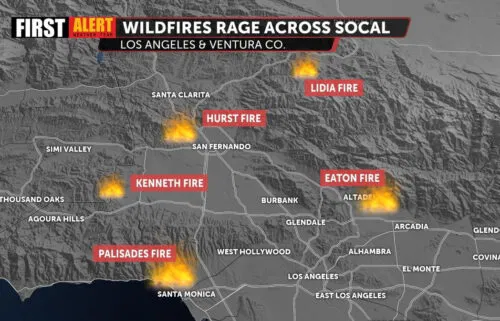COVID-19 hospitalizations reach record high, HHS data shows
By Travis Caldwell, Jason Hanna and Deidre McPhillips, CNN
The number of US patients hospitalized with COVID-19 has hit a record high — adding strain to health care networks and pushing states toward emergency staffing and other measures as they struggle to cope.
More than 145,900 people were in US hospitals with COVID-19 as of Tuesday — surpassing the previous peak from January 2021, and more than twice as many as two weeks ago, according to data from the Department of Health and Human Services.
The previous peak was 142,246, on January 14, 2021, according to HHS. During the Delta-variant surge over the summer, the number peaked at about 104,000 on September 1.
The hospitalization record comes amid a surge in cases fueled by the highly transmissible Omicron coronavirus variant. Hospitals are increasingly juggling staffing issues — not just because of the increased demand, but also because their employees, who are at a high risk of infection, have to isolate and recover after testing positive.
In Virginia, Gov. Ralph Northam declared a limited state of emergency Monday after the number of ICU hospitalizations more than doubled since December 1. The order allows hospitals to expand bed capacity and gives more flexibility in staffing, he said, adding that it also expands the use of telehealth as well as expanding which medical professionals can give vaccines.
In Texas, at least 2,700 medical staffers are being hired, trained and deployed to assist with the surge, joining more than 1,300 personnel already sent across the state, the Texas Department of State Health Services said in a statement to CNN.
Kentucky has mobilized the National Guard to provide support, with 445 members sent to 30 health care facilities, the state announced.
“Omicron continues to burn through the commonwealth, growing at levels we have never seen before. Omicron is significantly more contagious than even the Delta variant,” said Kentucky Gov. Andy Beshear, noting the earlier variant that spurred a surge of cases in the summer and fall months.
“If it spreads at the rate we are seeing, it is certainly going to fill up our hospitals,” he said, and Kentucky is “down to 134 adult ICU beds available.”
Mitigation measures such as mandatory masking are also being revived in some areas.
Delaware Gov. John Carney signed a universal indoor mask mandate Monday due to the increase in hospitalizations, with some hospitals “over 100% inpatient bed capacity amid crippling staffing shortages,” he said in a statement. Churches and places of worship are exempt from the mandate, while businesses should provide masks to customers and have signage about indoor mask requirements.
“I know we’re all exhausted by this pandemic. But at the level of hospitalizations we’re seeing, Delawareans who need emergency care might not be able to get it. That’s just a fact. It’s time for everyone to pitch in and do what works. Wear your mask indoors. Avoid gatherings or expect to get and spread COVID. Get your vaccine and, if eligible, get boosted. That’s how we’ll get through this surge without endangering more lives,” Carney said.
As the Omicron variant has spread, COVID-19 cases have exploded.
The US averaged more than 754,200 new COVID-19 cases daily over the last week, according to Johns Hopkins University data. That’s about three times last winter’s peak average (251,987 on January 11, 2021), and 4.5 times the peak from the Delta-driven surge (166,347 on September 1), according to JHU.
The country has averaged 1,646 COVID-19 deaths a day over the last week — 33% higher than a week ago, according to JHU. The peak average was 3,402 daily on January 13, 2021, JHU data shows.
The Omicron variant caused 98.3% of new coronavirus cases in the US last week, according to estimates posted Tuesday by the US Centers for Disease Control and Prevention.
Share of hospitalizations from breakthrough infections is growing, but risks for unvaccinated are higher
The HHS data on COVID-19 hospitalizations includes both those patients who are hospitalized because of COVID-19 complications and those who may have been admitted for something else but test positive for COVID-19. This has been true throughout the pandemic, though the share of patients who fall into each category may have changed over time.
Fully vaccinated people are accounting for a growing share of people hospitalized with COVID-19 — but hospitalizations among people who received a booster shot are still rare, and the gap in risk by vaccination status has been wide.
Between April and July 2021, before the emergence of the Omicron variant, more than 90% of COVID-19 hospitalizations were among people who were either unvaccinated or partially vaccinated, according to a study published by the CDC.
But a sampling of data collected by CNN suggests that figure has dropped to somewhere between 60% and 75% in recent days and months:
• In Pennsylvania, about 75% of COVID-19 hospitalizations between September and early December 2021 were among people who were not fully vaccinated, according to data from the state health department.
• In New York, about 61% of COVID-19 hospitalizations during the week ending January 2, 2022 were among people who were not fully vaccinated, according to data from the state health department.
• Beaumont Health, the largest health care system in Michigan, reported on Thursday that 62% of COVID-19 patients in its eight hospitals were unvaccinated.
In some hospitals, up to 40% of patients with COVID-19 “are coming in not because they’re sick with COVID, but because they’re coming in with something else and have had COVID or the Omicron variant detected,” CDC Director Dr. Rochelle Walensky told Fox News on Sunday.
But COVID-19 cases in hospitals strain resources, regardless of whether a patient was hospitalized because of COVID-19, CNN chief medical correspondent Dr. Sanjay Gupta said.
“If they get (incidentally) diagnosed with COVID in the hospital, they still need to go into infection protocol — personal protective equipment, all of that still needs to be utilized. So it’s a huge drain on the system overall,” Gupta said Tuesday.
While fully vaccinated people are accounting for a larger share of COVID-19 hospitalizations, multiple accounts suggest that those who are fully vaccinated and boosted account for a small share.
In the University of Maryland Medical System, less than 5% of hospitalized patients were fully vaccinated and boosted, President and CEO Dr. Mohan Suntha said Thursday. Beaumont Health reported Thursday that only 8% of COVID-19 patients were fully vaccinated and boosted.
The CDC did not respond to CNN’s multiple requests for data on the share of COVID-19 hospitalizations by vaccination status.
The agency publishes data on its website regarding the relative risk by vaccination status. Cumulatively, the risk of hospitalization has been eight times higher for unvaccinated people than for fully vaccinated people. But in the last week of November, CDC data showed that hospitalization rates were about 17 times higher for unvaccinated people than for fully vaccinated people.
Schools and industries face Omicron issues
The debate over safety in schools from COVID-19 continues to play out as only about one in six children ages 5 to 11 is fully vaccinated, according to data from the CDC.
As Los Angeles prepared to return to school on Tuesday, approximately 62,000 students and staff had tested positive for COVID-19 and will have to stay home, data from the Los Angeles Unified School District showed Monday, equating to a 14.99% positivity rate. The positivity rate of Los Angeles County at large, by comparison, has spiked to 22%.
In Chicago, educators will return to school Tuesday and students are slated for in-person learning Wednesday following a nearly weeklong dispute. The Chicago Teachers Union had voted to teach remotely last week, and the school district responded by canceling classes for four days.
The agreement, announced late Monday, included metrics for when a classroom would need to go remote due to COVID-19 levels.
In areas where schools have returned to in-person learning after the holiday break, the time needed for those with COVID-19 to recover has impacted some essential services.
Other sectors also are struggling due to high infection rates.
Some municipalities have seen nearly a quarter of their trash collection workforce call in sick in recent weeks due to COVID-19, leading to delays, according to the Solid Waste Association of North America.
“This coincided, unfortunately, with increased trash and recycling volumes associated with the holidays. However, we hope that as volumes decline and sanitation workers return to work, these delays will prove temporary,” executive director and CEO David Biderman said in a statement Monday.
In travel, US airlines canceled thousands of additional flights over the weekend due to COVID-19 callouts and winter storms, and cruise line Royal Caribbean International announced it has canceled voyages on four ships because of “ongoing COVID-related circumstances around the world.” Last week, Norwegian Cruise Line canceled the voyages of eight ships.
Public transit systems in major metropolitan areas such as New York City and Washington, DC, have had to scale back service with employees ill from COVID-19. In Detroit, 20-25% of SMART bus service is canceled or delayed, the agency said in a statement Saturday.
The-CNN-Wire
™ & © 2022 Cable News Network, Inc., a WarnerMedia Company. All rights reserved.
CNN’s Rosa Flores, Claudia Dominguez, David Shortell, Pete Muntean, Melissa Alonso, Hannah Sarisohn, Cheri Mossburg and Jenn Selva contributed to this report.






